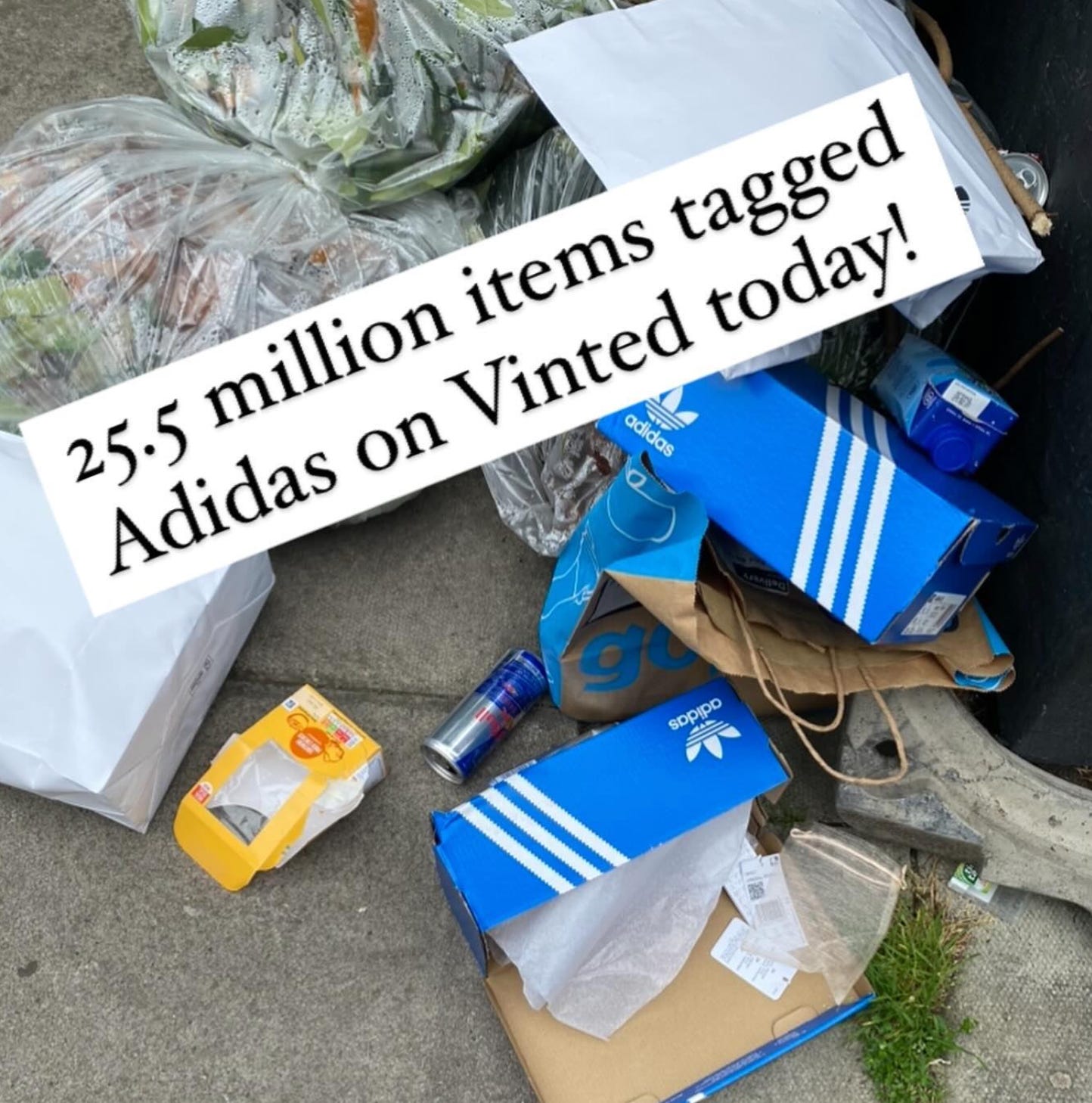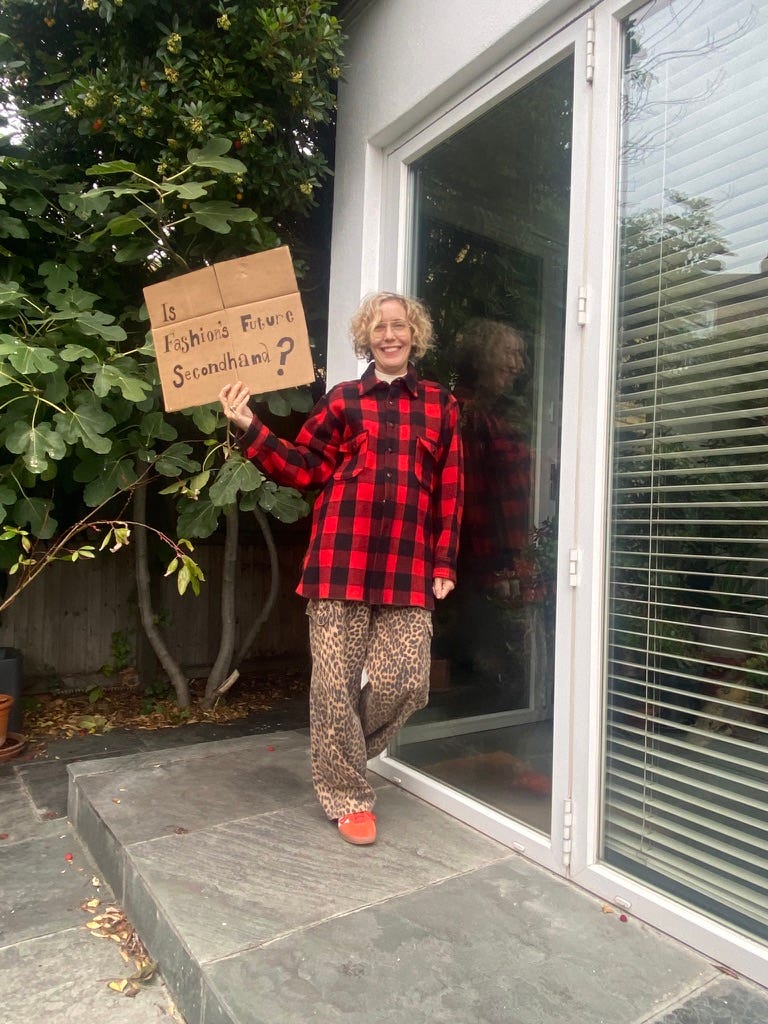Could you buy what you're wearing today secondhand?
There are around 23 billion secondhand clothes in circulation, yet people still tell me that shopping preloved can be difficult. Why? Last week I conducted a little experiment to investigate....
There are a lot of secondhand clothes out there in the world - the best estimate from The Or Foundation is that there are around 23 billion used apparel items in recirculation globally.
Just searching on Vinted today I found 75.1 million items tagged Zara. That’s more than one piece each for each of the 68.3 million people living in the UK. But don’t worry if Zara isn’t your thing you can also shop 70.6 million secondhand H&M items, 38.1 million secondhand items from Nike, 25.2 million secondhand items from Primark and 12 million secondhand items from Next - all on Vinted (20/10/24). I’ve added the date because I think there will be more tomorrow! Take a look and let me know…
And it’s not just so called fast fashion brands. There are also 8.5 million items tagged Ralph Lauren, 1.1 million items tagged Burberry, 864k items tagged Louis Vuitton and even 371k items tagged Prada all available for re-sale on Vinted.
What’s interesting is despite the fact that “globally there are enough clothes already in existence to dress the next six generations” lots of people still tell me that finding what they’re looking for secondhand is difficult. Why?
I decided to conduct an experiment…
Last week, on my The Elephant in my Wardrobe Instagram feed, I asked people to look down at what they were wearing and, if they had the time, to do a bit of research and tell me whether they could re-buy their outfit secondhand.
Testing the theory:
I tested the theory to see if I could replace my own outfit, all of which was purchased secondhand, with more secondhand clothes?
The trainers would be really easy to replace. There were 25.5 million Adidas items on Vinted, including dozens of pairs of red gazelles in a size 6 or 6.5 - many of them unused and still in the box.
I thought the vintage plaid shirt would be more difficult but there were 157.7k items tagged Woolrich and I quickly found something similar. There were even 9.7k items tagged Damson Madder and another pair of these leopard jeans in my size! I only looked on Vinted and with more time I’m sure I could have found many more options on Ebay or Depop?
The results…
The majority of people who commented told me that the clothes they were wearing were secondhand already. Of the those who took up the challenge, 18 people said they could replace their entire outfit secondhand, 12 people could (or would) replace some items secondhand , only 3 people definitely couldn’t find replacements, and 1 person would rather buy new clothes.
What’s “insanely” easy to replace secondhand?
For some people it was “insanely” easy to find everything they were wearing secondhand online, finding replacements “took less than 5 minutes” and “I could replace my whole outfit for £25.”
Some people expressed surprise that they could find replacements for vintage items or pieces they’d owned for years - “I thought it might be hard to find the old Next dress I’m wearing today secondhand as I’ve had it for over 7 years. But I found it!!!”
This sounds like good news for my hoped for secondhand future! However, deeper analysis of the comments suggests that some things - like trainers or popular ‘on trend’ pieces from big brands - are significantly easier to replace secondhand than other items. Lots of people, myself included, have bought preloved Adidas trainers but there was only “one pair of brown brogues from Crockett and Jones” and no secondhand TAOS slippers.
What can’t be replaced secondhand?
People found replacing “unique” or “handmade” items difficult, replacing good quality pieces from smaller independent brands was often impossible and finding clothes made from natural fibres like wool and linen was flagged as a real problem.
The secondhand market is subservient to the mainstream fashion industry and relies on trends in our apparel consumption, or overconsumption, for its stock. My MA research revealed that some of the main motivations for shopping secondhand are the pleasure of discovering “unique” treasure and the idea of accessing better quality clothing.
This raises concerns that a secondhand market flooded with the mostly polyester clothing we’re buying from big brands will become a much less interesting and appealing place to shop in the future. Does that worry you?
An interesting question?
Lots of people in my instagram community make their own clothes and commented that these would be irreplaceable and raises interesting questions about whether there is, or needs to be a market for secondhand ‘handmade’ clothes.
Given the growth in the sewing community I imagine there could be a lot of ‘homemade’ clothes that will need new homes in the future but lack the implied provenance and resale value of branded clothing? Would you buy secondhand ‘homemade’ clothes?
The big problem?
Often people could find what the items they were looking for, but “there are currently 0 pairs in my size.” The secondhand market reflects, and amplifies, the lack of size inclusivity within the mainstream fashion industry and it’s much easier to shop secondhand if you’re a fairly standard size - I “didn’t find my Clarks boots, but I’m a size 8 and I find it harder to find than say a size 5 or 6.”
This matters because according to Mintel in 2010 almost 40% of women in the UK were size 16 or above, and yet there is still less choice for them in mainstream brands and secondhand stores. And, for sustainability initiatives targeting making a quarter of all our wardrobes secondhand by 2030, addressing inclusivity issues around size availability needs to be a priority.
What won’t people buy secondhand?
Lots of people told me the only things they won’t buy secondhand are shoes, underwear, and possibly pyjamas, suggesting many of us still have concerns around the cleanliness and hygiene of secondhand apparel. Conversely, people also talked about ‘new’ shoes still in their boxes and ‘new’ with tags underwear that are available on some resale platforms.
For me, this starts to raise interesting questions about how we define secondhand? Are my ‘secondhand’ Adidas trainers that arrived looking as good as new in the original box are really secondhand? And is buying unworn secondhand underwear from Vinted basically the same as buying new? What do you think?
My conclusions…
I hope the results of this experiment indicate that a future where people can choose to shop secondhand as a viable alternative to buying new is a real possibility; but for this to happen the secondhand market will need to take meaningful action to address its lack of size inclusivity.
And the results left me wondering whether the growing secondhand market can avoid becoming subsumed by excessive amounts of ‘fast fashion’ stock and retain it’s appeal as a somewhere people can find ‘unique’ pieces, good quality independent brands and vintage treasure.






Interesting that this arrived in my inbox today because unlike when I sent my reply, I’m wearing everything memade except bra, socks and shoes. I can find things that look similar but I wouldn’t want to buy them.
I try always to use up the fabric for something else if they get too tatty (or too small!) because I know most charity shops want brands because their buyers do too.
Last year I bought a home sewn 1980s dress from a charity shop- I could tell because of the machine stitches used- I took the time to try it on and it was as if it had been made for me. It’s beautiful and people comment on it every time I wear it. I find myself thinking of the woman who made it and who was my body twin. Clothes should mean something and I’d be only too happy to buy secondhand clothing made by skilled home seamsters because they would have meaning. Does that make sense?
Your article was as thought provoking as ever.
Really interesting discussion. Just thinking about the difference here in second hand and resale. Evidently even if you find them on the same platform there is a difference. Where do some of these items (new with tags) come from? Is there a grey market here in stolen or otherwise acquired new goods.
I’m not sure that resale necessarily equates to second hand and therefore question how this works within the circular economy.